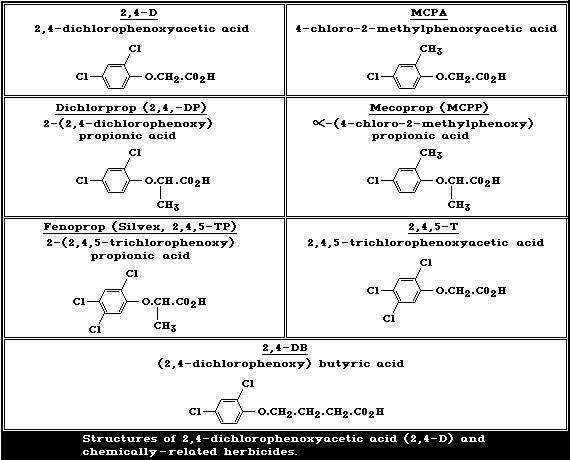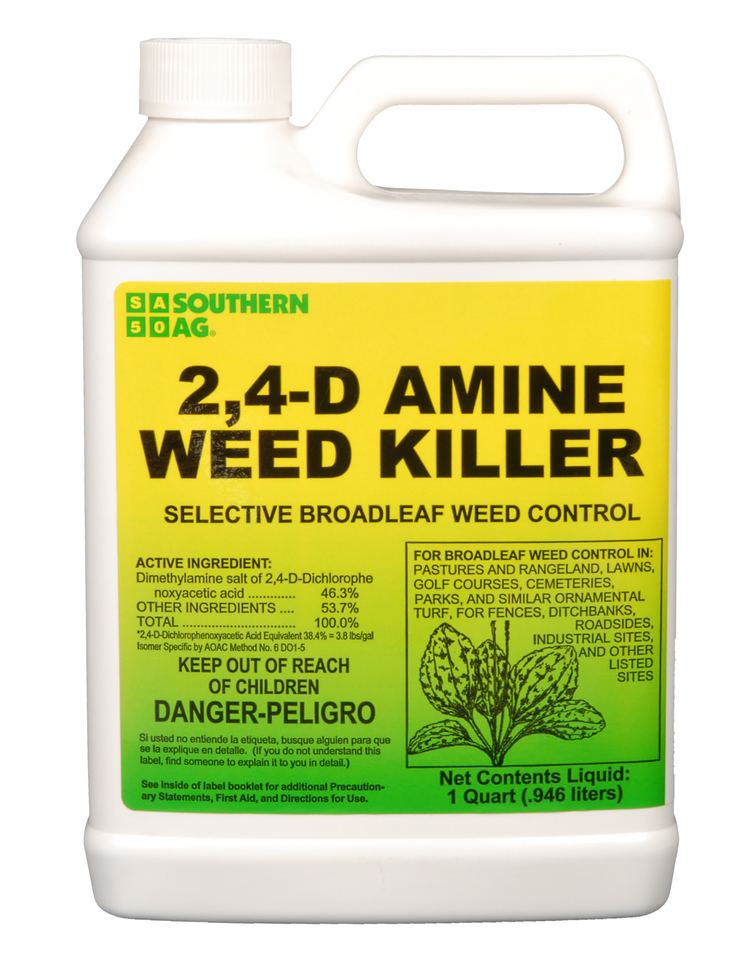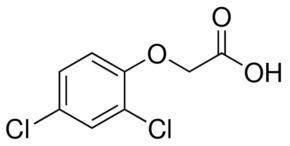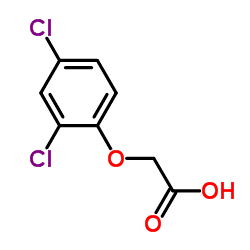Appearance white to yellow powder Formula C8H6Cl2O3 | Related compounds Classification Glycolates | |
 | ||
2 4 dichlorophenoxyacetic acid
2,4-Dichlorophenoxyacetic acid (usually called 2,4-D) is an organic compound with the chemical formula C8H6Cl2O3. It is a systemic herbicide which selectively kills most broadleaf weeds by causing uncontrolled growth in them, but leaves most grasses such as cereals, lawn turf, and grassland relatively unaffected.
Contents
- 2 4 dichlorophenoxyacetic acid
- Controversies
- Applications
- Health effects
- Acute toxicity
- Cancer risk
- Contaminants
- Metabolism
- Environmental behavior
- Microbial breakdown
- Regulation
- Mode of action
- Manufacture
- Genetically modified crops
- History
- References

2,4-D is one of the oldest and most widely available herbicides in the world, having been commercially available since 1945, and is now produced by many chemical companies since the patent on it has long since expired. It can be found in numerous commercial lawn herbicide mixtures, and is widely used as a weedkiller on cereal crops, pastures, and orchards. Over 1,500 herbicide products contain 2,4-D as an active ingredient.

Controversies

2,4-D is a possible carcinogen per WHO. The International Agency for Research on Cancer (IARC), the specialized cancer agency of the World Health Organization said 2,4-D was classified as "possibly carcinogenic to humans (Group 2B), based on inadequate evidence in humans and limited evidence in experimental animals". This puts 2,4-D in the same risk category as coffee and red meat but rates it as less likely to be carcinogenic than processed meat, which was placed in Group 1.
Some ester forms are highly toxic to fish and other aquatic life.

2,4-D was one of the ingredients in Agent Orange, a herbicide widely used during the Vietnam War. However, another ingredient in Agent Orange, 2,4,5-T (since banned in the United States), and its contaminant dioxin, were the cause of the adverse health effects associated with Agent Orange.
Applications

2,4-D is primarily used as a selective herbicide which kills many terrestrial and aquatic broadleaf weeds, but not grasses. It acts by mimicking the action of the plant growth hormone auxin, which results in uncontrolled growth and eventually death in susceptible plants. Because it was discovered in the 1940s, there is no longer a patent governing the manufacture and sale of 2,4-D, and any company is free to produce it. Thus, it is sold in various formulations under a wide variety of brand names. 2,4-D can be found in commercial lawn herbicide mixtures, which often contain other active ingredients including mecoprop and dicamba. Over 1,500 herbicide products contain 2,4-D as an active ingredient.
A wide variety of different sectors use products containing 2,4-D to kill weeds and unwanted vegetation. In agriculture, it was the first herbicide found to be capable of selectively killing weeds but not crops. It has been used since 1945 to control broad-leafed weeds in pastures, orchards, and cereal crops such as corn, oats, rice and wheat. Cereals, in particular, have excellent tolerance to 2,4-D when it is applied before planting. 2,4-D is the cheapest way for farmers to control winter annual weeds by spraying in the fall, often at the lowest recommended rate. This is particularly effective before planting beans, peas, lentils and chickpeas.
In domestic lawn and garden maintenance, 2,4-D is commonly used for weed control in lawns and other turf. It is used to kill unwanted weeds such as dandelions, plantain, clover and chickweed. In forestry, it is used for stump treatment, trunk injection, and selective control of brush in conifer forests. Along roadways, railways, and power lines it is used to control weeds and brush which might interfere with safe operation and damage equipment. Along waterways it is used to control aquatic weeds that might interfere with boating, fishing and swimming or clog irrigation and hydroelectric equipment. It is often used by government agencies to control the spread of invasive, noxious and non-native weed species and prevent them from crowding out native species, and also to control many poisonous weeds such as poison ivy and poison oak.
A 2010 monitoring study conducted in the US and Canada found that "current exposures to 2,4-D are below applicable exposure guidance values."
2,4 D has been used in laboratories for plant research as a supplement in plant cell culture media such as MS medium since at least 1962. 2,4-D is used in plant cell cultures as a dedifferentiation (callus induction) hormone. It is classified as an auxin plant hormone derivative.
Some scientists are also experimenting with soaking tomatoes in 2,4-D as a way of slowing their ripening after they are harvested.
Health effects
Men who work with 2,4-D are at risk for abnormally shaped sperm and thus fertility problems; the risk depends on the amount and duration of exposure and other personal factors.
Acute toxicity
According to the U.S. Environmental Protection Agency, "The toxicity of 2,4-D depends on its chemical forms, including salts, esters, and an acid form. 2,4-D generally has low toxicity for humans, except certain acid and salt forms can cause eye irritation. Swimming is restricted for 24 hours after application of certain 2,4-D products applied to control aquatic weeds to avoid eye irritation." As of 2005 the median lethal dose or LD50 determined in acute toxicity rat studies was 639 mg/kg.
Urinary alkalinisation has been used in acute poisoning, but evidence to support its use is poor.
Cancer risk
In June 2015 the World Health Organization's (WHO) International Agency for Research on Cancer (IARC) confirmed its 1987 classification of 2,4-D as a possible carcinogen.
On August 8, 2007, the EPA issued a ruling that existing data do not support a link between human cancer and 2,4-D exposure.
A 1995 panel of 13 scientists reviewing studies on the carcinogenicity of 2,4-D had divided opinions. None of the scientists thought the weight of the evidence indicated that 2,4-D was a “known” or “probable” cause of human cancer. The predominant opinion indicated that it is possible that 2,4-D can cause cancer in humans, although not all of the panelists believed the possibility was equally likely: one thought the possibility was strong, leaning toward probable, and five thought the possibility was remote, leaning toward unlikely. Two panelists believed it unlikely that 2,4-D can cause cancer in humans.
In a prior 1987 report the IARC classified some chlorphenoxy herbicides including 2,4-D, MCPA and 2,4,5-T as a group as class 2B carcinogens - "possibly carcinogenic to humans".
Contaminants
A July 2013 Four Corners investigation found elevated levels of dioxins in a generic version of 2,4-D, one of Australia's most widely used herbicides. One scientist said the product tested by Four Corners, which was imported from China, had "one of the highest dioxin readings for 2,4-D in the last 10 to 20 years, and could pose potential health risks."
Metabolism
When radioactively-labeled 2,4 D was fed to livestock, 90% or more of the total radioactive residue (TRR) was shed in urine unchanged or as conjugated forms of 2,4-D. A relatively small portion of 2,4 D was metabolized into dichlorophenol and into dichloroanisole and 4-chlorophenoxyacetic acid. (6.9% of the TRR in milk) and 2,4-dichlorophenol13 (5% of the TRR in milk; 7.3% of the TRR in eggs and 4% of the TRR in chicken liver). Residue levels in kidney were the highest.
Environmental behavior
Owing to the longevity and extent of use, 2,4-D has been evaluated several times by regulators and review committees.
2,4-D amine salts and esters are not persistent under most environmental conditions. The degradation of 2,4-D is rapid (half life of 6.2 days) in aerobic mineral soils. 2,4-D is broken down by microbes in soil, in processes that involve hydroxylation, cleavage of the acid side-chain, decarboxylation, and ring opening. The ethyl hexyl form of the compound is rapidly hydrolyzed in soil and water to form the 2,4-D acid. 2,4-D has a low binding affinity in mineral soils and sediment, and in those conditions is considered intermediately to highly mobile, and therefore likely to leach if not degraded.
In aerobic aquatic environments, the half life is 15 days, while in anaerobic aquatic environments, 2,4-D was moderately persistent to persistent (half life of = 41 to 333 days). 2,4-D has been detected in streams and shallow groundwater at low concentrations, in both rural and urban areas. Breakdown is pH dependent.
"The ester forms of 2,4-D can be highly toxic to fish and other aquatic life. 2,4-D generally has moderate toxicity to birds and mammals, is slightly toxic to fish and aquatic invertebrates, and is practically nontoxic to honeybees" per EPA.
Microbial breakdown
A number of 2,4-D-degrading bacteria have been isolated and characterized from a variety of environmental habitats. Metabolic pathways for the compound’s degradation have been available for many years, and genes encoding 2,4-D catabolism have been identified for several organisms. As a result of the extensive metadata on environmental behavior, physiology and genetics, 2,4-D was the first herbicide for which the bacteria actively responsible for in situ degradation was demonstrated. This was accomplished using the technique of DNA-based stable isotope probing, which enables a microbial function (activity), such as degrading a chemical, to be linked with the organism’s identity without the need to culture the organism involved.
Regulation
Maximum residue limits were first set in the EU in 2002 and re-evaluated by the European Food Safety Authority in 2011. EFSA concluded that the codex maximum residue limits were "not expected to be of concern for European consumers". The total chronic exposure represented less than 10% of the acceptable daily intake (ADI). Concern over 2,4-D is such that it is currently not approved for use on lawns and gardens in Denmark, Norway, Kuwait and the Canadian provinces of Québec and Ontario. 2,4-D use is severely restricted in the country of Belize. In 2008, Dow AgroScience, LLC sued the federal government for allowing Quebec to ban 2,4-D, but settled in 2011.
In 2005, the US EPA approved the continued use of 2,4-D. On July 10, 2013 the Pest Management Regulatory Agency in Canada updated the re-evaluation notice of 2,4-D stating that the 2,4-D registrants had provided it with required data and deemed them acceptable. On April 18, 2012, EPA denied the petition filed November 6, 2008 by the Natural Resources Defense Council (NRDC) to revoke all tolerances and to cancel all registrations of 2,4-D. EPA stated that recent new study and EPA’s comprehensive review confirmed EPA’s previous finding that the 2,4-D tolerances are safe at anticipated exposure.
In October 2014, the US EPA registered Enlist Duo, a herbicide containing the less volatile 2,4-D choline salt, glyphosate, and an anti-drift agent, for use in six states: Illinois, Indiana, Iowa, Ohio, South Dakota, and Wisconsin. In November 2015 the EPA attempted to withdraw its own approval of Enlist Duo, as a result of legal actions against both the agency and Dow by two U.S. groups. However, while it was implied that the approval was "gone" because of the action, in fact Enlist Duo was still approved pending a decision by the courts. On January 25, 2016 the US Ninth Circuit Court of Appeals denied EPA's motion to vacate its Enlist Duo registration. Dow stated the product would be available in 15 US states and Canada for the 2016 crop season.
On 21 August 2013 the Australian Pesticides and Veterinary Medicines Authority (APVMA) banned selected 2,4-D high volatile ester (HVE) products due to their environmental hazards. HVE 2, 4-D products had already been banned in Europe and North America for twenty years; low volatile ester products continue to be available in Australia and worldwide. In July 2013 APVMA published their report findings.
Mode of action
2,4-D is a synthetic auxin, which is a class of plant hormones. It is absorbed through the leaves and is translocated to the meristems of the plant. Uncontrolled, unsustainable growth ensues, causing stem curl-over, leaf withering, and eventual plant death. 2,4-D is typically applied as an amine salt, but more potent ester versions exist as well.
Manufacture
2,4-D is a member of the phenoxy family of herbicides.
2,4-D is manufactured from chloroacetic acid and 2,4-dichlorophenol, which is itself produced by chlorination of phenol. Alternatively, it may be produced by the chlorination of phenoxyacetic acid. The production processes create several contaminants including di-, tri-, and tetrachlorodibenzo-p-dioxin isomers and N-nitrosamines, as well as monochlorophenol.
Genetically modified crops
In 2010 Dow published that it had created genetically modified soybeans made resistant to 2,4-D by insertion of a bacterial aryloxyalkanoate dioxygenase gene, aad1. Dow intended it to be used as an alternative or complement to Roundup Ready crops due to the increasing prevalence of glyphosate resistant weeds.
As of April 2014 genetically modified maize and soybeans resistant to 2,4-D and glyphosate have been approved in Canada. In September 2014 the USDA also approved Dow's maize and soybeans, and in October the EPA registered the "Enlist Duo" herbicide containing 2,4-D and glyphosate.
History
The discovery of 2,4-D as well as the similar hormone herbicides 2,4,5-T, and MCPA occurred during WWII and was a case of multiple discovery by four groups working independently under wartime secrecy in the United Kingdom and the United States: William G. Templeman and associates at Imperial Chemical Industries in the UK; Philip S. Nutman and associates at Rothamsted Research in the UK; Franklin D. Jones and associates at the American Chemical Paint Company; and Ezra Kraus, John W. Mitchell, and associates at the University of Chicago and the U.S. Department of Agriculture. All four groups were subject to wartime secrecy laws and did not follow the usual procedures of publication and patent disclosure. The first scientific publications about these herbicides were by other workers who were not the original discovers, so the exact order of discovery is a matter of some debate.
William Tempelman found that Indole-3-acetic acid, the natural occurring auxin was used at high concentrations it could stop plant growth. In 1940 he published his finding that IAA killed broadleaf plants within a cereal field. The related compound, MCPA, was discovered at about the same time by other UK scientists.
The search for an acid with a longer half life, i.e. a metabolically and environmentally more stable compound, led to 2,4-dichlorophenoxyacetic acid (2,4-D) and 2,4,5-trichlorophenoxyacetic acid (2,4,5-T), both phenoxy herbicides and analogs of IAA. Robert Pokorny, an industrial chemist for the C.B. Dolge Company in Westport, Connecticut, published their synthesis in 1941.
Both compounds were developed as part of a clandestine wartime effort to create chemical warfare agents for use in World War II; although 2,4-D was not used this way in WWII. Britain and the U.S. were looking for a chemical to starve Germany and Japan into submission by killing their potato and rice crops, but 2,4-D was found to be ineffective for that purpose because both crops are tolerant of it. Within a year after the war ended, 2,4-D was commercially released as an herbicide to control broadleaf weeds in grain crops such as rice, and in the 1950s it was registered in the United States to control size and enhance skin colour in potatoes without affecting yields.
The first publication of 2,4-D's as a selective herbicide" came in 1944. Starting in 1945 the American Chemical Paint Company brought 2,4-D to market as an herbicide called "Weedone". It revolutionized weed control, as it was the first compound that, at low doses, could selectively control dicots (broadleaf plants), but not most monocots - narrow leaf crops like wheat, maize (corn), rice, and similar cereal grass crops. At a time when labor was scarce and there was a huge need for increased food production, it literally "replaced the hoe".
2,4-D was one of the ingredients in Agent Orange, the herbicide widely used during the Vietnam war. According to the US National Pesticide Information Center, "the controversy regarding health effects centered around the 2,4,5-T component of the herbicide and its contaminant, dioxin."
In the 2000s Dow Agrosciences developed a new choline salt version of 2,4-D (2,4-D choline) that Dow included in its "Enlist Duo" herbicide along with glyphosate and an agent that reduces drift; the choline salt form of 2,4-D is less volatile than 2,4-D.
